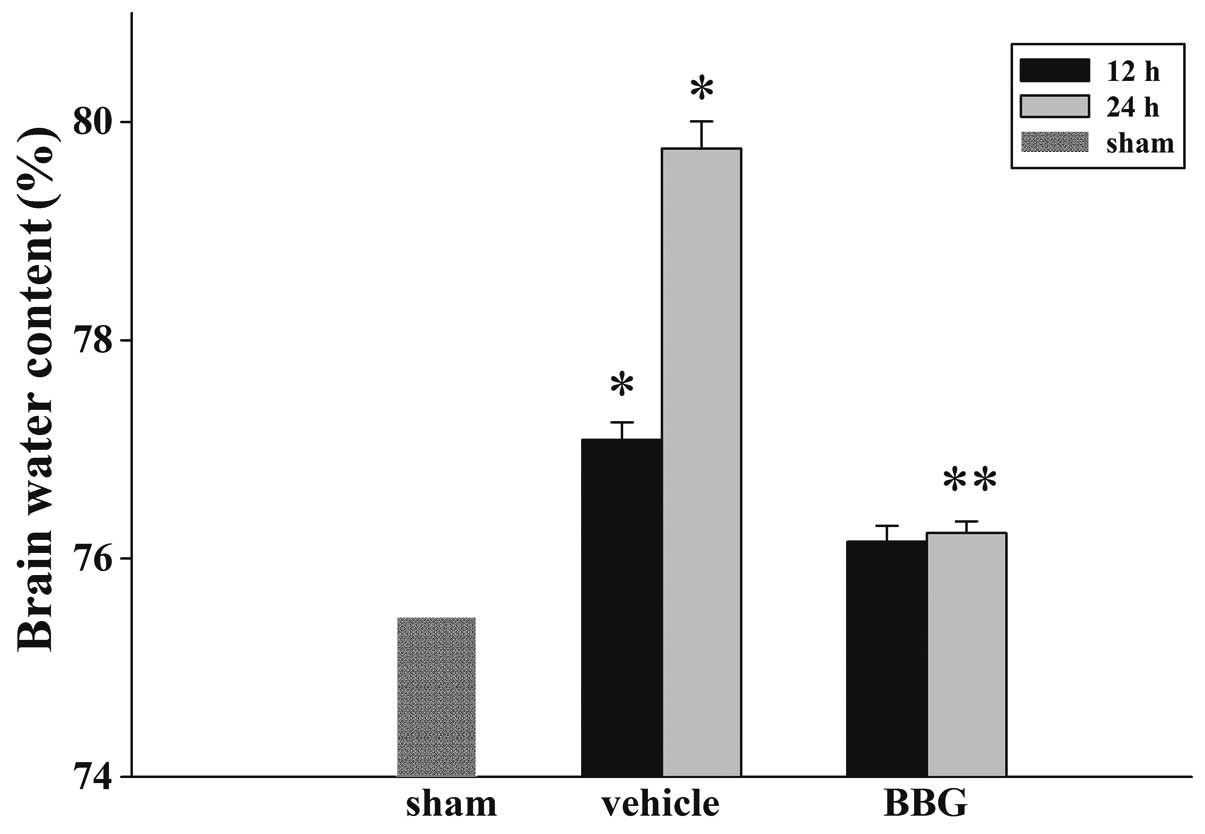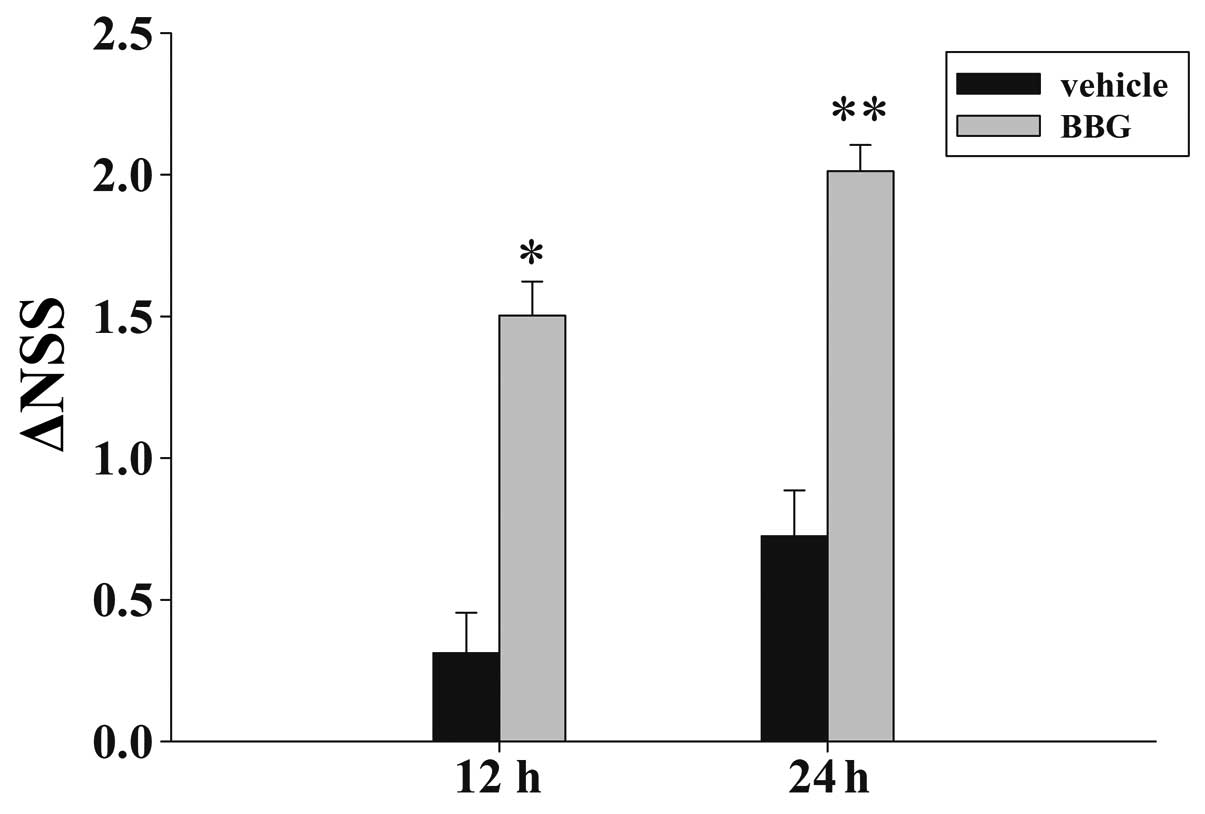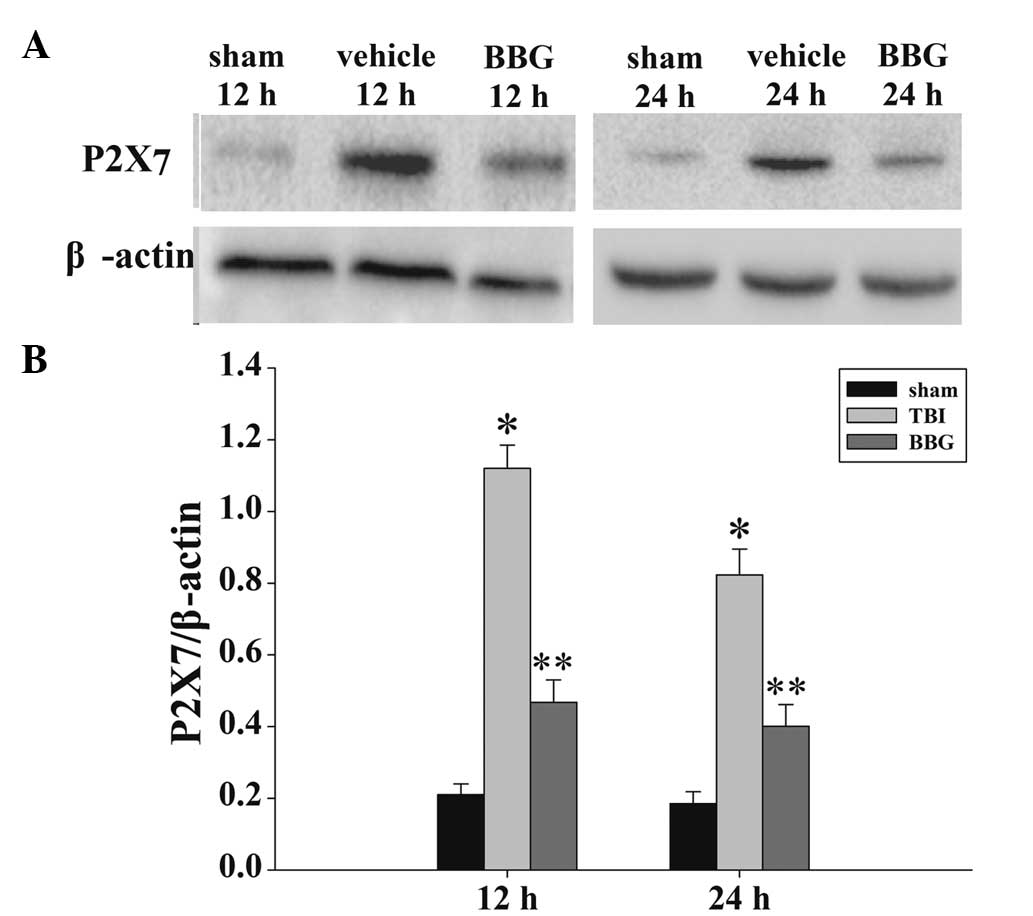|
1
|
Nortje J and Menon DK: Traumatic brain
injury: physiology, mechanisms, and outcome. Curr Opin Neurol.
17:711–718. 2004. View Article : Google Scholar : PubMed/NCBI
|
|
2
|
Bramlett HM and Dietrich WD: Progressive
damage after brain and spinal cord injury: pathomechanisms and
treatment strategies. Prog Brain Res. 161:125–141. 2007.PubMed/NCBI
|
|
3
|
Song SX, Gao JL, Wang KJ, et al:
Attenuation of brain edema and spatial learning deficits by the
inhibition of NADPH oxidase activity using apocynin following
diffuse traumatic brain injury in rats. Mol Med Rep. 7:327–331.
2013.
|
|
4
|
Levin HS, Eisenberg HM, Gary HE, et al:
Intracranial hypertension in relation to memory functioning during
the first year after severe head injury. Neurosurgery. 28:196–199.
1991. View Article : Google Scholar : PubMed/NCBI
|
|
5
|
Saul TG and Ducker TB: Effect of
intracranial pressure monitoring and aggressive treatment on
mortality in severe head injury. J Neurosurg. 56:498–503. 1982.
View Article : Google Scholar : PubMed/NCBI
|
|
6
|
Chessell IP, Hatcher JP, Bountra C, et al:
Disruption of the P2X7 purinoceptor gene abolishes chronic
inflammatory and neuropathic pain. Pain. 114:386–396. 2005.
View Article : Google Scholar : PubMed/NCBI
|
|
7
|
Labasi JM, Petrushova N, Donovan C, et al:
Absence of the P2X7 receptor alters leukocyte function and
attenuates an inflammatory response. J Immunol. 168:6436–6445.
2002. View Article : Google Scholar : PubMed/NCBI
|
|
8
|
Le Feuvre R, Brough D and Rothwell N:
Extracellular ATP and P2X7 receptors in neurodegeneration. Eur J
Pharmacol. 447:261–269. 2002. View Article : Google Scholar : PubMed/NCBI
|
|
9
|
Solle M, Labasi J, Perregaux DG, et al:
Altered cytokine production in mice lacking P2X(7) receptors. J
Biol Chem. 276:125–132. 2001. View Article : Google Scholar
|
|
10
|
Parvathenani LK, Tertyshnikova S, Greco
CR, Roberts SB, Robertson B and Posmantur R: P2X7 mediates
superoxide production in primary microglia and is up-regulated in a
transgenic mouse model of Alzheimer’s disease. J Biol Chem.
278:13309–13317. 2003. View Article : Google Scholar : PubMed/NCBI
|
|
11
|
Sperlágh B, Vizi ES, Wirkner K and Illes
P: P2X7 receptors in the nervous system. Prog Neurobiol.
78:327–346. 2006. View Article : Google Scholar : PubMed/NCBI
|
|
12
|
Sanz JM and Di Virgilio F: Kinetics and
mechanism of ATP-dependent IL-1beta release from microglial cells.
J Immunol. 164:4893–4898. 2000. View Article : Google Scholar : PubMed/NCBI
|
|
13
|
Surprenant A, Rassendren F, Kawashima E,
North R and Buell G: The cytolytic P2Z receptor for extracellular
ATP identified as a P2X receptor (P2X7). Science. 272:735–738.
1996. View Article : Google Scholar : PubMed/NCBI
|
|
14
|
Calogero S, Grassi F, Aguzzi A, et al: The
lack of chromosomal protein Hmg1 does not disrupt cell growth but
causes lethal hypoglycaemia in newborn mice. Nat Genet. 22:276–280.
1999. View Article : Google Scholar : PubMed/NCBI
|
|
15
|
Takenouchi T, Sugama S, Iwamaru Y,
Hashimoto M and Kitani H: Modulation of the ATP-lnduced release and
processing of IL-1beta in microglial cells. Crit Rev Immunol.
29:335–345. 2009. View Article : Google Scholar : PubMed/NCBI
|
|
16
|
Folkersma H, Brevé JJ, Tilders FJ, Cherian
L, Robertson CS and Vandertop WP: Cerebral microdialysis of
interleukin (IL)-1beta and IL-6: extraction efficiency and
production in the acute phase after severe traumatic brain injury
in rats. Acta Neurochir (Wien). 150:1277–1284. 2008. View Article : Google Scholar
|
|
17
|
Herx LM, Rivest S and Yong VW: Central
nervous system-initiated inflammation and neurotrophism in trauma:
IL-1β is required for the production of ciliary neurotrophic
factor. J Immunol. 165:2232–2239. 2000. View Article : Google Scholar : PubMed/NCBI
|
|
18
|
Kamm K, Vanderkolk W, Lawrence C, Jonker M
and Davis AT: The effect of traumatic brain injury upon the
concentration and expression of interleukin-1beta and
interleukin-10 in the rat. J Trauma Acute Care Surg. 60:152–157.
2006. View Article : Google Scholar
|
|
19
|
Kinoshita K, Chatzipanteli K, Vitarbo E,
Truettner JS, Alonso OF and Dietrich WD: Interleukin-1beta
messenger ribonucleic acid and protein levels after
fluid-percussion brain injury in Rats: importance of injury
severity and brain temperature. Neurosurgery. 51:195–203. 2002.
View Article : Google Scholar : PubMed/NCBI
|
|
20
|
Laird MD, Sukumari-Ramesh S, Swift AE,
Meiler SE, Vender JR and Dhandapani KM: Curcumin attenuates
cerebral edema following traumatic brain injury in mice: a possible
role for aquaporin-4? J Neurochem. 113:637–648. 2010. View Article : Google Scholar : PubMed/NCBI
|
|
21
|
Taupin V, Toulmond S, Serrano A, Benavides
J and Zavala F: Increase in IL-6, IL-1 and TNF levels in rat brain
following traumatic lesion: Influence of pre-and post-traumatic
treatment with Ro5 4864, a peripheral-type (p site) benzodiazepine
ligand. J Neuroimmunol. 42:177–185. 1993. View Article : Google Scholar : PubMed/NCBI
|
|
22
|
Shiozaki T, Hayakata T, Tasaki O, et al:
Cerebrospinal fluid concentrations of anti-inflammatory mediators
in earlyphase severe traumatic brain injury. Shock. 23:406–410.
2005. View Article : Google Scholar : PubMed/NCBI
|
|
23
|
Hayakata T, Shiozaki T, Tasaki O, et al:
Changes in CSF S100B and cytokine concentrations in early-phase
severe traumatic brain injury. Shock. 22:102–107. 2004. View Article : Google Scholar : PubMed/NCBI
|
|
24
|
Chiaretti A, Genovese O, Aloe L, et al:
Interleukin 1beta and interleukin 6 relationship with paediatric
head trauma severity and outcome. Childs Nerv Syst. 21:185–193.
2005. View Article : Google Scholar
|
|
25
|
Clausen F, Hånell A, Björk M, et al:
Neutralization of interleukin-1beta modifies the inflammatory
response and improves histological and cognitive outcome following
traumatic brain injury in mice. Eur J Neurosci. 30:385–396. 2009.
View Article : Google Scholar : PubMed/NCBI
|
|
26
|
Jones NC, Prior MJ, Burden Teh E, Marsden
CA, Morris PG and Murphy S: Antagonism of the interleukin-1
receptor following traumatic brain injury in the mouse reduces the
number of nitric oxide synthase-2-positive cells and improves
anatomical and functional outcomes. Eur J Neurosci. 22:72–78. 2005.
View Article : Google Scholar : PubMed/NCBI
|
|
27
|
Tehranian R, Andell-Jonsson S, Beni SM, et
al: Improved recovery and delayed cytokine induction after closed
head injury in mice with central overexpression of the secreted
isoform of the interleukin-1 receptor antagonist. J Neurotrauma.
19:939–951. 2002. View Article : Google Scholar : PubMed/NCBI
|
|
28
|
Toulmond S and Rothwell NJ: Interleukin-1
receptor antagonist inhibits neuronal damage caused by fluid
percussion injury in the rat. Brain Res. 671:261–266. 1995.
View Article : Google Scholar : PubMed/NCBI
|
|
29
|
Kishimoto A, Mikawa K, Hashimoto K, et al:
Limited proteolysis of protein kinase C subspecies by
calcium-dependent neutral protease (calpain). J Biol Chem.
264:4088–4092. 1989.PubMed/NCBI
|
|
30
|
Nishizuka Y: Protein kinase C and lipid
signaling for sustained cellular responses. FASEB J. 9:484–496.
1995.PubMed/NCBI
|
|
31
|
Ohno S: The distinct biological potential
of PKC isotypes. Protein Kinase C. Parker PJ and Deckker LV: RG
Landes; Texas, USA: pp. 178–188. 1997
|
|
32
|
Saito N, Kikkawa U, Nishizuka Y and Tanaka
C: Distribution of protein kinase C-like immunoreactive neurons in
rat brain. J Neurosci. 8:369–382. 1988.PubMed/NCBI
|
|
33
|
Huang FL, Yoshida Y, Nakabayashi H, Young
WS III and Huang KP: Immunocytochemical localization of protein
kinase C isozymes in rat brain. J Neurosci. 8:4734–4744.
1988.PubMed/NCBI
|
|
34
|
Tanaka C and Saito N: Localization of
subspecies of protein kinase C in the mammalian central nervous
system. Neurochem Int. 21:499–512. 1992. View Article : Google Scholar : PubMed/NCBI
|
|
35
|
Matsumoto S, Murozono M, Nagaoka D, et al:
Isoflurane inhibits protein kinase Cgamma and calcium/calmodulin
dependent protein kinase II-alpha translocation to synaptic
membranes in ischemic mice brains. Neurochem Res. 33:2302–2309.
2008. View Article : Google Scholar : PubMed/NCBI
|
|
36
|
Marmarou A, Foda MA, van den Brink W,
Campbell J, Kita H and Demetriadou K: A new model of diffuse brain
injury in rats: Part I: Pathophysiology and biomechanics. J
Neurosurg. 80:291–300. 1994. View Article : Google Scholar : PubMed/NCBI
|
|
37
|
Tang J, Liu J, Zhou C, et al: Mmp-9
deficiency enhances collagenase-induced intracerebral hemorrhage
and brain injury in mutant mice. J Cerebral Blood Flow Metab.
24:1133–1145. 2004. View Article : Google Scholar
|
|
38
|
Beni-Adani L, Gozes I, Cohen Y, et al: A
peptide derived from activity-dependent neuroprotective protein
(ADNP) ameliorates injury response in closed head injury in mice. J
Pharmacol Exp Ther. 296:57–63. 2001.
|
|
39
|
Whelan-Goodinson R, Ponsford J, Johnston L
and Grant F: Psychiatric disorders following traumatic brain
injury: their nature and frequency. J Head Trauma Rehabil.
24:324–332. 2009. View Article : Google Scholar : PubMed/NCBI
|
|
40
|
Rogers JM and Read CA: Psychiatric
comorbidity following traumatic brain injury. Brain Inj.
21:1321–1333. 2007. View Article : Google Scholar : PubMed/NCBI
|
|
41
|
Wang X, Arcuino G, Takano T, et al: P2X7
receptor inhibition improves recovery after spinal cord injury. Nat
Med. 10:821–827. 2004. View
Article : Google Scholar : PubMed/NCBI
|
|
42
|
Kimbler DE, Shields J, Yanasak N, Vender
JR and Dhandapani KM: Activation of P2X7 promotes cerebral edema
and neurological injury after traumatic brain injury in mice. PloS
One. 7:e412292012. View Article : Google Scholar : PubMed/NCBI
|
|
43
|
Elssner A, Duncan M, Gavrilin M and Wewers
MD: A novel P2X7 receptor activator, the human cathelicidin-derived
peptide LL37, induces IL-1beta processing and release. J Immunol.
172:4987–4994. 2004. View Article : Google Scholar : PubMed/NCBI
|
|
44
|
Peng W, Cotrina ML, Han X, et al: Systemic
administration of an antagonist of the ATP-sensitive receptor P2X7
improves recovery after spinal cord injury. Proce Natl Acad Sci
USA. 106:12489–12493. 2009. View Article : Google Scholar
|
|
45
|
Iwashita A, Muramatsu Y, Yamazaki T, et
al: Neuroprotective efficacy of the peroxisome
proliferator-activated receptor delta-selective agonists in vitro
and in vivo. J Pharmacol Exp Ther. 320:1087–1096. 2007. View Article : Google Scholar
|
|
46
|
Karpiak SE, Mahadik SP and Wakade CG:
Ganglioside reduction of ischemic injury. Crit Rev Neurobiol.
5:221–237. 1990.PubMed/NCBI
|
|
47
|
Jiang LH, Mackenzie AB, North RA and
Surprenant A: Brilliant blue G selectively blocks ATP-gated rat
P2X7 receptors. Mol Pharmacol. 58:82–88. 2000.PubMed/NCBI
|














